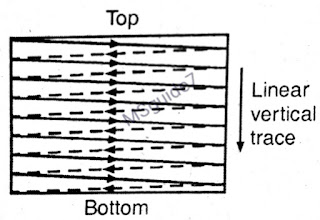Scanning is the process by which an optical information is converted into an electrical information. In a scanning process, a scene is divided into small parts. After this, each part of it is scanned by electron beam. From which we get the voltage at the output of the camera according to the brightness label of the scene. This entire process is called scanning.
TV. Each view in the system is scaled in both horizontal and vertical directions. Commercial T.V The scanning rate is 24 frames per second, while most TVs. The scanning rate in the system is 25 frames per second.
- Horizontal Scanning
- Vertical Scanning
The time taken to reach the current from zero value to maximum value in the sha tooth voltage is called the trace period and the time taken to reach the zero value from the maximum value is called the retention period.
In ideal condition, the value of the retrace period is zero. But this is not possible experimentally. But the retrace period has a very low value. As shown in Fig . During the trace period, the electron beam moves from left to right on the raster. And in the retrace period, the electron beam comes back from the right to the left on the raster.
Vertical Scanning:- In the process of vertical scanning, the saw tooth current is applied on the vertical deflection coil, during the trace period of the tooth wave, the electron beam moves from top to bottom on the raster, and the retrace. During the period the electron beam again returns to the top of the raster as shown in the figure
In the process of interlaced scanning, a frame of 625 line is divided into two parts. As a result, two fields are created, which are called even field and odd field respectively. After this, each field is scanned sequentially. This type of scanning is called interlace scanning.









0 Comments
Please give your suggestions in comments.